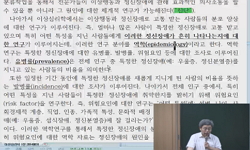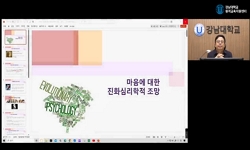정지용의 난해시 중 하나인 「슬픈 偶像」에 관한 연구는 오랫동안 초기 연구에서 제시한 두 가지 명제에서 크게 벗어나지 못했다. 두 가지 명제란 이 작품이 종교시라는 것과 이 작품에 묘...
http://chineseinput.net/에서 pinyin(병음)방식으로 중국어를 변환할 수 있습니다.
변환된 중국어를 복사하여 사용하시면 됩니다.
- 中文 을 입력하시려면 zhongwen을 입력하시고 space를누르시면됩니다.
- 北京 을 입력하시려면 beijing을 입력하시고 space를 누르시면 됩니다.

정지용의 시 「슬픈 偶像」의 재해석과 그로 인한 질문들 = Reinterpretation of Jungjiyong"s poem “Sad idol” and its questions
한글로보기https://www.riss.kr/link?id=A102637537
- 저자
- 발행기관
- 학술지명
- 권호사항
-
발행연도
2016
-
작성언어
Korean
-
주제어
정지용 ; 이상 ; 「슬픈 우상」 ; 「수수어4」 ; 구인회 ; Jungjiyong ; Risang ; “Sad Idol” ; “Susueo4” ; Guinhoe(nine people club)
-
등재정보
KCI등재
-
자료형태
학술저널
-
수록면
233-258(26쪽)
-
KCI 피인용횟수
5
- DOI식별코드
- 제공처
-
0
상세조회 -
0
다운로드
부가정보
국문 초록 (Abstract)
「愁誰語(4)」및 그 개작인 「슬픈 偶像」을 이상의 죽음에 대한 정지용의 추도사로 해석하게 되면 정지용의 문학 및 정지용과 구인회의 관계에 관해 새로운 시각에서 접근해야 할 필요성이 제기된다. 정지용과 이상 사이의 문학적 교류 양상이 어떠했으며, 그러한 교류가 서로의 문학에 어떠한 영향을 주었는지가 두 작가의 문학 텍스트에 대한 분석을 통해 해명되어야 한다. 또한 「슬픈 偶像」을 종교시가 아니라고 해석하면 정지용 문학의 시기 구분 역시 재고해야 한다. 정지용과 구인회의 관계가 기존 연구를 통해 알려진 것보다 더 긴밀한 것이라면 정지용 시의 변모양상은 ‘초기 시/ 종교시/ 구인회 활동 시/ 후기 시’로 구분하는 것이 적절하다.
정지용의 난해시 중 하나인 「슬픈 偶像」에 관한 연구는 오랫동안 초기 연구에서 제시한 두 가지 명제에서 크게 벗어나지 못했다. 두 가지 명제란 이 작품이 종교시라는 것과 이 작품에 묘사된 대상이 성모마리아라는 것이다. 그러나 「슬픈 偶像」을 검토해보면 그러한 두 가지 명제 모두 확실한 근거가 없다는 사실이 드러난다. 따라서 이 논문에서는 그러한 두 가지 고정관념을 배제한 채 작품을 분석해 보고자 하였다. 이를 위해 주목한 것은 「슬픈 偶像」이라는 시로 개작되기 이전에 산문으로 발표된 「愁誰語(4)」의 맥락이었다. 「愁誰語(4)」가 발표된 시점과 관련된 맥락을 검토해보면 이 작품이 이상의 죽음에 대한 추도사로 쓰인 것이라는 추론이 가능하게 되고, 이러한 추론은 작품 분석을 통해서 입증된다. 이 작품은 「流線哀傷」에서와 같이 여러 이미지를 결합하여 시적 대상에 대한 확정을 지연시키면서도 이상문학의 모티프와 이미지를 차용하여 이상 문학에 대한 정지용의 견해와 추도의 마음을 드러내고 있다.
「愁誰語(4)」및 그 개작인 「슬픈 偶像」을 이상의 죽음에 대한 정지용의 추도사로 해석하게 되면 정지용의 문학 및 정지용과 구인회의 관계에 관해 새로운 시각에서 접근해야 할 필요성이 제기된다. 정지용과 이상 사이의 문학적 교류 양상이 어떠했으며, 그러한 교류가 서로의 문학에 어떠한 영향을 주었는지가 두 작가의 문학 텍스트에 대한 분석을 통해 해명되어야 한다. 또한 「슬픈 偶像」을 종교시가 아니라고 해석하면 정지용 문학의 시기 구분 역시 재고해야 한다. 정지용과 구인회의 관계가 기존 연구를 통해 알려진 것보다 더 긴밀한 것이라면 정지용 시의 변모양상은 ‘초기 시/ 종교시/ 구인회 활동 시/ 후기 시’로 구분하는 것이 적절하다.
다국어 초록 (Multilingual Abstract)
Interpretation of “Susueo4” and its adaptation “Sad Idol” as Jungjiyong"s memorial address for Risang"s death calls for a new perspective on Jungjiyong"s literature and the relationship between Jungjiyong and Guinhoe(nine people club). What was the aspect of literary exchanges between Jungjiyong and Risang, and how such exchanges influenced each other"s literature should be explained through Jungjiyong and Risang"s literary texts. If we interpret the “Sad idol” as a memorial address for the death of Risang rather than religious poem, the period division of Jungjiyong"s literature should be redefined. If the relationship between Jungjiyong and Guinhoe is more intimate than what is known through previous researches, then the changing aspect of Jungjiyong"s poetry should be divided into "early poetry/ religious poetry/ Guinhoe poetry/ late poetry". This “Sad idol” is a text that raises the necessity of approaching the literature of Jungjiyong and Guinhoe from a different point of view.
The study of “Sad idol”, one of JungJiyong"s esoteric poems, has not been far removed from the two propositions presented in earlier works. Two propositions are that this text is a religious poem and that the object depicted in this text is the Vi...
The study of “Sad idol”, one of JungJiyong"s esoteric poems, has not been far removed from the two propositions presented in earlier works. Two propositions are that this text is a religious poem and that the object depicted in this text is the Virgin Mary. However, examining the “Sad idol” reveals that both of those propositions have no clear basis. Therefore, this study tried to analyze the meaning of text by excluding those two stereotypes. To this end, this study focuses on the context of “Susueo4”, which was published as prose before it was changed to the poem “Sad idol”. Considering the context at the time of the publication of “Susueo4”, it can be inferred that this text was written as a memorial address to Risang"s death. And such reasoning is evidenced through text analysis. This text unfolds Jungjiyong"s views and remembrance of Risang"s literature by borrowing the motifs and images of Risang"s literature while combining various images such as “Yuaeonaesang” to delay confirmation of poetic objects.
Interpretation of “Susueo4” and its adaptation “Sad Idol” as Jungjiyong"s memorial address for Risang"s death calls for a new perspective on Jungjiyong"s literature and the relationship between Jungjiyong and Guinhoe(nine people club). What was the aspect of literary exchanges between Jungjiyong and Risang, and how such exchanges influenced each other"s literature should be explained through Jungjiyong and Risang"s literary texts. If we interpret the “Sad idol” as a memorial address for the death of Risang rather than religious poem, the period division of Jungjiyong"s literature should be redefined. If the relationship between Jungjiyong and Guinhoe is more intimate than what is known through previous researches, then the changing aspect of Jungjiyong"s poetry should be divided into "early poetry/ religious poetry/ Guinhoe poetry/ late poetry". This “Sad idol” is a text that raises the necessity of approaching the literature of Jungjiyong and Guinhoe from a different point of view.
목차 (Table of Contents)
- 국문초록
- 1. 서론
- 2. 「愁誰語4」와 「슬픈 偶像」의 차이
- 3. ‘슬픈 우상’이 된 ‘박제가 되어버린 천재’
- 4. 「슬픈 偶像」의 재검토가 제기하는 질문들
- 국문초록
- 1. 서론
- 2. 「愁誰語4」와 「슬픈 偶像」의 차이
- 3. ‘슬픈 우상’이 된 ‘박제가 되어버린 천재’
- 4. 「슬픈 偶像」의 재검토가 제기하는 질문들
- 5. 결론
- 참고문헌
- 영문초록
참고문헌 (Reference)
1 김윤식, "한국근대문학사상사" 한길사 1984
2 배호남, "정지용의 산문시 형성 과정에 관한 고찰-「슬픈 偶像」과 「愁誰語 4」를 중심으로 -" 국어문학회 55 (55): 81-98, 2013
3 장영우, "정지용과 ‘구인회’ -『시와 소설』의 의의와 「유선애상」의 재해석" 한국문학연구소 (39) : 139-169, 2010
4 남기혁, "정지용 중·후기시에 나타난 풍경과 시선, 재현의 문제 - 식민지적 근대와 시선의 계보학(4)" 국어문학회 47 (47): 111-148, 2009
5 신범순, "이상의 무한정원 삼차각 나비" 현암사 2007
6 이숭원, "원본 정지용 시집" 깊은샘 2003
7 정지용, "백록담" 문장사 1941
8 김승구, "근대적 피로와 미적 초월의 욕망 - 1930년대 중반 정지용 시를 중심으로" 한국문학연구소 (41) : 187-217, 2011
9 김기림, "고 이상의 추억" 1937
10 吳鐸藩, "韓國 現代詩史의 對位的 構造 : 素月詩와 芝溶詩의 詩史的 意義" 고려대학교 대학원 1983
1 김윤식, "한국근대문학사상사" 한길사 1984
2 배호남, "정지용의 산문시 형성 과정에 관한 고찰-「슬픈 偶像」과 「愁誰語 4」를 중심으로 -" 국어문학회 55 (55): 81-98, 2013
3 장영우, "정지용과 ‘구인회’ -『시와 소설』의 의의와 「유선애상」의 재해석" 한국문학연구소 (39) : 139-169, 2010
4 남기혁, "정지용 중·후기시에 나타난 풍경과 시선, 재현의 문제 - 식민지적 근대와 시선의 계보학(4)" 국어문학회 47 (47): 111-148, 2009
5 신범순, "이상의 무한정원 삼차각 나비" 현암사 2007
6 이숭원, "원본 정지용 시집" 깊은샘 2003
7 정지용, "백록담" 문장사 1941
8 김승구, "근대적 피로와 미적 초월의 욕망 - 1930년대 중반 정지용 시를 중심으로" 한국문학연구소 (41) : 187-217, 2011
9 김기림, "고 이상의 추억" 1937
10 吳鐸藩, "韓國 現代詩史의 對位的 構造 : 素月詩와 芝溶詩의 詩史的 意義" 고려대학교 대학원 1983
11 정지용, "愁誰語 4"
12 정지용, "愁誰語 2"
13 신범순, "1930년대 시에서 니체주의적 사상 탐색의 한 장면(1) - 구인회의 ‘별무리의 사상’을 중심으로" 인문학연구원 72 (72): 11-58, 2015
동일학술지(권/호) 다른 논문
-
이광수의 『재생』에 나타난 식민지 가족법의 모순과 이상적 가정의 모색
- 한국현대문학회
- 이행미(Lee, Haeng-mi)
- 2016
- KCI등재
-
- 한국현대문학회
- 조윤정(Jo, Yun-jeong)
- 2016
- KCI등재
-
- 한국현대문학회
- 권희철(Kwon heecheol)
- 2016
- KCI등재
-
- 한국현대문학회
- 김미영(Kim, Mee-young)
- 2016
- KCI등재
분석정보
인용정보 인용지수 설명보기
학술지 이력
| 연월일 | 이력구분 | 이력상세 | 등재구분 |
|---|---|---|---|
| 2026 | 평가예정 | 재인증평가 신청대상 (재인증) | |
| 2020-01-01 | 평가 | 등재학술지 유지 (재인증) |  |
| 2017-01-01 | 평가 | 등재학술지 유지 (계속평가) |  |
| 2013-01-01 | 평가 | 등재학술지 유지 (등재유지) |  |
| 2010-01-01 | 평가 | 등재학술지 유지 (등재유지) |  |
| 2008-10-10 | 학술지명변경 | 외국어명 : The Journal of Korean Modern Literature -> The Journal of Modern Korean Literature |  |
| 2007-01-01 | 평가 | 등재학술지 선정 (등재후보2차) |  |
| 2006-01-01 | 평가 | 등재후보 1차 PASS (등재후보1차) |  |
| 2004-01-01 | 평가 | 등재후보학술지 선정 (신규평가) |  |
학술지 인용정보
| 기준연도 | WOS-KCI 통합IF(2년) | KCIF(2년) | KCIF(3년) |
|---|---|---|---|
| 2016 | 0.72 | 0.72 | 0.75 |
| KCIF(4년) | KCIF(5년) | 중심성지수(3년) | 즉시성지수 |
| 0.84 | 0.91 | 1.388 | 0.16 |




 DBpia
DBpia






